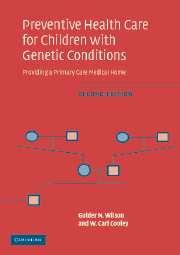Book contents
- Frontmatter
- Contents
- Preface
- Glossary of genetic and molecular terms
- Part I Approach to the child with special needs
- Part II The management of selected single congenital anomalies and associations
- 4 Congenital anomalies associated with developmental disability
- 5 Single anomalies, sequences, and associations
- 6 Teratogenic syndromes
- Part III Chromosomal syndromes
- Part IV Syndromes remarkable for altered growth
- Part V Management of craniofacial syndromes
- Part VI Management of connective tissue and integumentary syndromes
- Part VII The management of neurologic and neurodegenerative syndromes
- Part VIII Management of neurodegenerative metabolic disorders
- References
- Index
5 - Single anomalies, sequences, and associations
Published online by Cambridge University Press: 29 January 2010
- Frontmatter
- Contents
- Preface
- Glossary of genetic and molecular terms
- Part I Approach to the child with special needs
- Part II The management of selected single congenital anomalies and associations
- 4 Congenital anomalies associated with developmental disability
- 5 Single anomalies, sequences, and associations
- 6 Teratogenic syndromes
- Part III Chromosomal syndromes
- Part IV Syndromes remarkable for altered growth
- Part V Management of craniofacial syndromes
- Part VI Management of connective tissue and integumentary syndromes
- Part VII The management of neurologic and neurodegenerative syndromes
- Part VIII Management of neurodegenerative metabolic disorders
- References
- Index
Summary
Single anomalies are confined to one body region or organ system, while sequences and associations disrupt several systems. Isolated anomalies and sequences that spare the brain usually have good outcomes with proper medical and surgical management.
Because the embryo is a dynamic structure, anomalies occurring at one stage in development may lead to consequences in later stages (see Chapter 1). Renal agenesis (an isolated anomaly) initiates a cascade of consequences including oligohydramnios, facial deformations, and club feet (Potter sequence). This cascade or “sequence” of events has the low recurrence risk expected of isolated anomalies rather than the likelihood of genetic or chromosomal etiology implied by syndromes. Associations are clusters of major anomalies envisioned as parallel responses to early embryonic injury: they lack the minor anomalies of syndromes. Single anomalies, sequences, and associations usually have a low genetic recurrence risk in contrast to syndromes with likelihood of chromosomal or Mendelian inheritance. The single anomalies, sequences, and associations discussed in this chapter are listed in Table 5.1.
Preventive management can be lifesaving for disorders such as Pierre Robin sequence, or facilitate palliative care and postmortem counseling for disorders such as Potter sequence. In anomalies such as cleft palate, informed management prevents complications such as hearing loss and speech delay. One page summaries are presented for common anomalies, followed by short paragraphs on rarer defects and more extensive checklists for the VATER and CHARGE associations.
- Type
- Chapter
- Information
- Preventive Health Care for Children with Genetic ConditionsProviding a Primary Care Medical Home, pp. 90 - 115Publisher: Cambridge University PressPrint publication year: 2006



